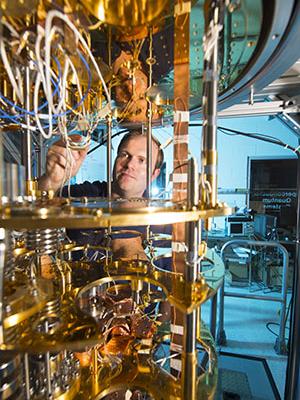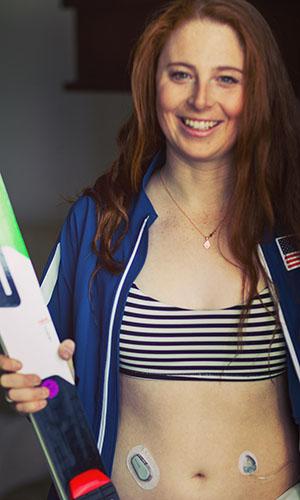A Quantum Quest: Eric Holland '09
Eric Holland’s physics professors told him to aim high. Their advice and support—along with an early interest in math and an insatiable curiosity— launched him on an exciting career path. He holds a Ph.D. from Yale and works as the deputy director of quantum technology at Fermilab, a world-class particle physics laboratory near Chicago.

Asked what he does, Holland usually answers that he’s a scientist. Asked for more detail, however, he says he is developing a next generation technology to make computers exponentially more efficient.
“We’ve enjoyed 70 years of technological innovation in regular computing using transistors,” he explains. “In 1947, the first electrical transistor was the size of a cat. Now you have billions of them in your smartphone. There’s a global push to harness the tremendous untapped potential of quantum technologies.”
Quantum computers store and process more data, and do it a million times faster, than conventional computers. “It’s difficult to predict exactly what complex problems will be solved with existing quantum computers,” Holland says. “That will become more apparent once we get quantum technologies in the hands of more people and more innovative solutions come online,” Holland says. But he’s certain that over the next few decades its impact will be transformative.
Fermilab’s research is contracted by the United States Department of Energy through the Office of Science/High Energy Physics. Among the areas that will benefit are big data, communications security, and precision sensing. The quantum systems Holland is developing will be transferred to industry and used for applications such as financial forecasting, weather predictions, or the design and discovery of new drugs and fertilizers.
After completing doctoral studies in experimental condensed matter physics, Holland worked at Sematech, Inc., a research and development firm in Albany, N.Y., and then at Lawrence Livermore National Laboratory in California. He began working at Fermilab last summer.
A major influence on the young scientist was his grandfather, Thomas. He started out as a train conductor. After WWII, he decided he wanted to learn how to design computers. He spent his career at MIT Lincoln Laboratory.
“When my grandfather visited, I had the best time ever. He was a really smart guy who was always curious and I wanted to be like him. When I was a kid, I went to science camps where we did things like build a solar oven and use it to cook food. I didn’t use coloring books; I liked math books where you used equations to solve puzzles.”
He is still solving puzzles—only now, they are bigger. Exponentially bigger.
By Laurie D. Morrissey
Conquering The Slopes and Type 1 Diabetes: Lauren Salko '15
Lauren Salko ’15 doesn’t shy away from challenges. The lifelong downhill skier was diagnosed with Type I diabetes as a child but refused to let it dampen her athletic ambitions, competing in alpine events through high school and college. Now she’s focused on qualifying for the 2022 Olympic Games in one of winter’s most thrilling events: ski cross.

Salko first encountered ski cross in 2014. The frantic, physical event pits four racers head-to-head over jumps and around tight turns. In this high-speed roller derby on snow, one skier’s slip can quickly end another’s medal hopes. Sometimes just staying upright is the key to success. “It’s one of the purest forms of racing,” Salko says. She was hooked immediately.
“I ski as aggressively as I can while trying to maintain my ability to react quickly to the events around me,” Salko says. That strategy has helped lead her to success both on and off the slopes.
Salko chose Saint Anselm because the blend of athletics and a liberal arts education appealed to her, and her experiences there have had a lasting impact. “It helped me find my way in the world,” she says. “Saint A’s also helped me develop a strong sense of social responsibility.”
As a professional athlete with diabetes, Salko is now in a powerful position to inspire others, which she does as a speaker for Tandem Diabetes Care’s Live Life in Full Color speaker series. Her message is simple: “I would not be the athlete or person I am today if I did not have diabetes. Sure, diabetes is a challenge sometimes, but it also has shaped my life in incredible ways that I would never have imagined.”
For a professional athlete, those challenges are daily. Salko knows the exact blood sugar level at which she skis best, but bad weather, an injury to another skier, or other variables can make race day unpredictable. “Stress, excitement, and adrenaline all affect my blood sugar,” she says. So Salko uses a glucose monitor connected to an insulin pump to continuously monitor and adjust her glucose levels. Since her senior year of college she’s also had a teammate in this effort: Silas, a diabetic alert dog. The chocolate Lab can smell Salko’s blood sugar level and lets her know when it’s out of range.
With that system in place, Salko continues to thrive on the slopes. This past season she was the top American at the USASA national championship and ranked fourth on the North American Cup circuit for the season. Next up, she hopes, will be World Cup competition and the 2021 World Championships. Then, if all goes according to plan, it’s on to the 2022 Winter Olympics in Beijing.
By Marc Chalufour
